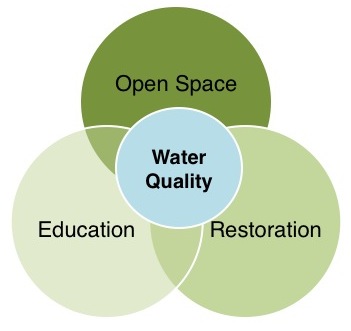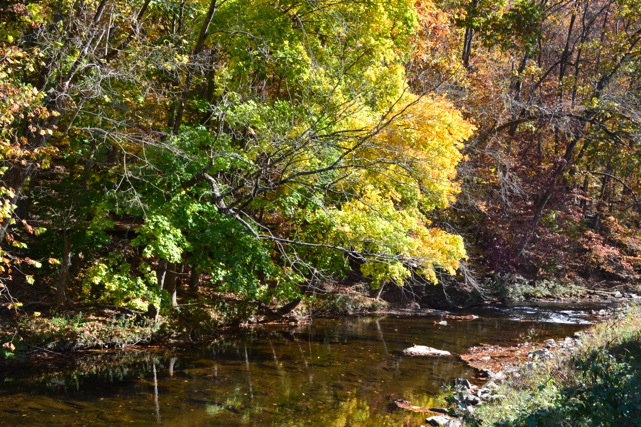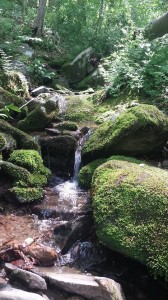 What do open space preservation, habitat restoration, and public awareness all have in common? The answer is simple. They are active concepts, that when put together in practice can help sustain good water quality in our local streams and rivers. The story of the Landenberg Junction Trail Restoration project is a great example that shows some of the ways these efforts are being implemented for the benefit of local residents and the White Clay Creek.
What do open space preservation, habitat restoration, and public awareness all have in common? The answer is simple. They are active concepts, that when put together in practice can help sustain good water quality in our local streams and rivers. The story of the Landenberg Junction Trail Restoration project is a great example that shows some of the ways these efforts are being implemented for the benefit of local residents and the White Clay Creek.
In December 2012, White Clay Creek Wild & Scenic Program contributed funds to assist New Garden Township with the purchase of the 1.2-acre Hendrickson Property. Following the land purchase, it was subsequently determined that the integrity of the historic structure occupying the site, familiarly known as the Hendrickson House, was too compromised to be saved. Therefore, the structure was removed in order to extend trails along the White Clay Creek for greater public access and benefit; approximately 3,500 square feet of impervious surface (surfaces that do not allow water to penetrate) was removed and replaced with native plants, which will benefit water quality by helping reduce erosion and increase infiltration.
The site, located on the eastern bank of the East Branch of the White Clay Creek in the vicinity of present-day Landenberg, has historical roots associated with nineteenth century textile mill and factory development. Two historic rail routes cut through this parcel: the Wilmington and Western, and the Pomeroy and Newark. Thus, the procurement of the land preserves an important part of Landenberg’s rich history.
The site’s acquisition and development, consistent with New Garden Township’s Comprehensive Plan, has been aimed at enhancing access as well as restoring, protecting, and conserving open space public lands. The endeavor also aligns closely with the White Clay Creek Management Plan’s mission to foster a cooperative approach to watershed management; the trailhead is part of the conceptual 17 mile White Clay Loop that will eventually link trails in New Garden Township, Franklin Township, London Grove Township, and London Britain Township. The Landenberg Junction Trail is still under construction, and will open in Spring 2015 (see map below).
 As a part of the restoration objective, riparian planting commenced at the site in September 2014. A riparian buffer is an area of trees, shrubs, and other vegetation along a stream or river that protects and maintains the integrity of the waterway. Riparian and wetland buffers serve to act as natural filters for streams, and reduce pollutants like sediment, nutrients, and metals, and can help manage and improve water quality. They also succeed in providing wetland habitat to local wildlife, and increasing aesthetic value.
As a part of the restoration objective, riparian planting commenced at the site in September 2014. A riparian buffer is an area of trees, shrubs, and other vegetation along a stream or river that protects and maintains the integrity of the waterway. Riparian and wetland buffers serve to act as natural filters for streams, and reduce pollutants like sediment, nutrients, and metals, and can help manage and improve water quality. They also succeed in providing wetland habitat to local wildlife, and increasing aesthetic value. The riparian planting event on Saturday September 13, 2014 brought out close to 50 community volunteers at the site who contributed by planting 1,400 native wildflowers, trees, and shrubs. The plant materials were purchased through a Grant provided by PECO’s Green Region Funds to the New Garden Township Open Space Committee. White Clay Wild and Scenic Program, North Creek Nurseries, and Friends of New Garden Trails facilitated the planning and implementation of the buffer planting. Click here to view the full photo gallery for the Landenberg Junction Trail habitat restoration.
The riparian planting event on Saturday September 13, 2014 brought out close to 50 community volunteers at the site who contributed by planting 1,400 native wildflowers, trees, and shrubs. The plant materials were purchased through a Grant provided by PECO’s Green Region Funds to the New Garden Township Open Space Committee. White Clay Wild and Scenic Program, North Creek Nurseries, and Friends of New Garden Trails facilitated the planning and implementation of the buffer planting. Click here to view the full photo gallery for the Landenberg Junction Trail habitat restoration.
Interested in future volunteer events? Join the White Clay Wild and Scenic Programs mailing list by contacting mpc@whiteclay.org or subscribe to this blog for future volunteer opportunities throughout the White Clay watershed. Looking to volunteer to help build & maintain the construction of the Landenberg Junction Trail or other Township trails? Please contact Friendsofthetrail@aol.com.
Check out some of our highlighted native plants below, and for the serious plant lovers we’ve also included a comprehensive plant list for this project.
Chelone glabra, White Turtlehead and the Baltimore Checkerspot

(Photo Sources: North Creek Nurseries, and Maryland DNR))
White Turtle Head grows best in moist meadows, stream banks, and swamps. The elegant white flowers bloom in late summer and early fall, and typically grow to a height of about 2-4 feet. White turtle head serves as the primary regional host plant for the Baltimore Checkerspot Butterfly.
Aesclepias incarnata, Swamp Milkweed and the Monarch
(Photo Sources: North Creek Nurseries, and National Geographic)
Swamp Milkweed attracts butterflies of all kinds and its leaves are a preferred food source of Monarch caterpillars. The plant prefers consistently moist soil and the bright pink and red flowers typically appear in June and July.
Complete Landenberg Junction Trail Plant List:
Landscape Plugs- White Wood Aster (Aster divaricatus) Aster Purple Dome (Aster n-a ‘Purple Dome’) Emory’s Sedge (Carex emoryi) Fox Sedge (Carex vulpinoidea) White Turtle Head (Chelone glabra) Southern Eastern Wild Rye (Elymus glabriflorus) Blue Mist Flower (Eupatorium coelestinum) Golden Groundsel (Packera aurea) Obedient Plant (Physostegia virginiana ‘Pink Manners’) Ohio Spiderwort (Tradescantia ohiensis) Swamp Milkweed (Asclepias incarnata) Blue Lobelia (Lobelia siphilitica) Bee Balm (Monarda didyma)
Seed Mix- Showy Tick Trefoil (Desmodium canandense) Cardinal Flower (Lobelia cardinalis) Boneset (Eupatorium perfoliatum) Monkey Flower (Mimulus ringens) Blue Stem Godenrod (Solidago caesia) NY Ironweed (Vernonia noveboracensis) Culver’s Root (Veronicastrum virginicum) Golden Alexander (Zizia aurea) White Turtlehead (Chelone glabra) Nodding Bur Marigold (Bidens cernua) New England Aster (Aster Novae-angliae) Ohio Spiderwort (Tradescantia ohiensis)
Shrubs/Trees- Witch Hazel (Hamamelis virginiana) Arrow Wood (Viburnum dentatum) Swamp White Oak (Quercus bicolor) Alternate Leaved Dogwood (Cornus alternifolia)








